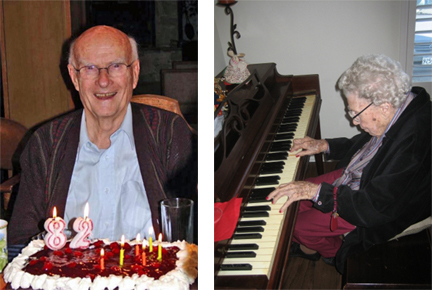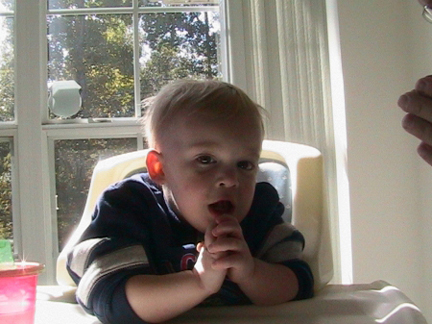The week before last, we looked at light — specifically, at how your camera attempts to evaluate and expose your shots for middle gray. This week, I want to look at another issue of light; I want to discuss using flash in your photos.
Here are a couple of shots from November’s photo challenge — the photographers used a flash with each.
You can tell the photographer used a flash because you can see a hard shadow outlining the subjects. Notice, too, that the cake and the piano keys closest to the camera are brighter than the rest of each photo, since they are closest to the bursting light of the flash.
Flash Tricks for Point-and-Shoot
** Flash Modes:
If all you have is a point-and-shoot camera, first check your manual to see if it has a fill flash or night-shooting mode. What these modes will do is evaluate the scene and adjust the amount of flash accordingly, which can soften those dark shadow lines.
** Diffusing:
Another thing to consider is diffusing the light to make it softer and less intense. While there are products on the market designed to do this with DSLR cameras, I am not aware of any made for point-and-shoot cameras. What you can do, however, is make your own diffuser.
When diffusing the light, you are attempting to spread it out and soften it up. One way to do this is to take a Kleenex or a white napkin and make a little sock-like cover over your pop up flash, leaving a little room between the flash and the tissue. This gives a space for the light to bounce around.
This one little cheap-and-easy trick is not an end-all professional solution, but it will make your images look more professional if all you have at your disposal is a point-and-shoot with on-camera flash.
Flash Tricks for DSLR Cameras:
** Diffusing:
If you have a more advanced DSLR, but no external flash, you could craft a diffuser out of tissue, but there are some great products on the market designed specifically for this purpose. (I posted one example in last week’s buying guide, the Puffer by Gary Fong.
** Bounce:
Another option you have with an external flash is to aim the flash at a white wall or ceiling to bounce the light back onto your subject. This creates a larger field of light, which is much softer with more natural results.
** Diffusion/Bounce Combined:
You can also combine these two techniques by bouncing your already diffused flash light for great results. Experiment, taking note of which techniques you used for which photos. That’s one of the great things about digital photography — you’re not wasting film when you try new techniques.
** Reflectors (for DSLR or point-and-shoot)
And finally, let’s take a look at one more shot. This is a perfect example of the camera reading the entire scene and aiming for middle gray, which I talked about in this eletter two weeks ago.
The shot has such strong back lighting from the window that the camera under exposed the little boy. You could accurately expose the child by using fill flash in your photo.
But another, perhaps better, alternative would be to leave the flash off and use a reflector. You can buy a reflector (see last Wednesday’s buying guide here) or use white poster board or a white bed sheet to reflect fill light onto your subject. Simply ask someone to hold your reflector so that the light from the window would be reflecting back at the little boy. This might take a little practice, but it works extremely well and produces very natural results.
The ultimate aim is to get your photos to look as natural as possible, so your subject can take the prominent roll in all your images. Practice. Trial-and-error is the only method I know for making that happen — employ these flash tricks, take heart and keep shooting.
I hope those of you who celebrated Thanksgiving had a wonderful holiday and had the opportunity to take some “family” shots for this month’s theme. There are a few more days left to get your photo entry into our monthly challenge, so take a few minutes now to post yours.
Submissions for this month’s photo challenge “A Season for Family” are due by 8:00 a.m. EST on Monday, December 3; we gave you extra time so you can take advantage of any family gathering you may have planned for this month.
[Editor’s Note: Learn more about how you can turn your pictures into cash in our free online newsletter The Right Way to Travel. Sign up here today and we’ll send you a new report, Selling Photos for Cash: A Quick-Start Guide, completely FREE.]
Travel Photography Resources
5 Dos and 2 Don’ts for Travel Photography
Take Great Photos And Get Paid More For Your Travel Articles
Turning a Photography Hobby into a Monthly Income
The Pros Of Selling Your Images As Stock Photography
16 Mobile Photography Tips And Tricks Every Photographer Should Know



